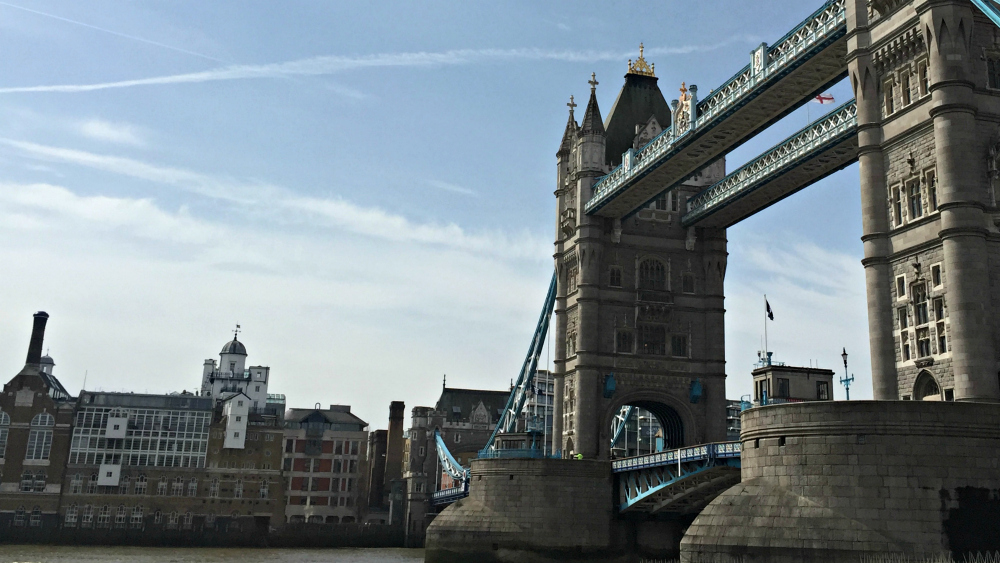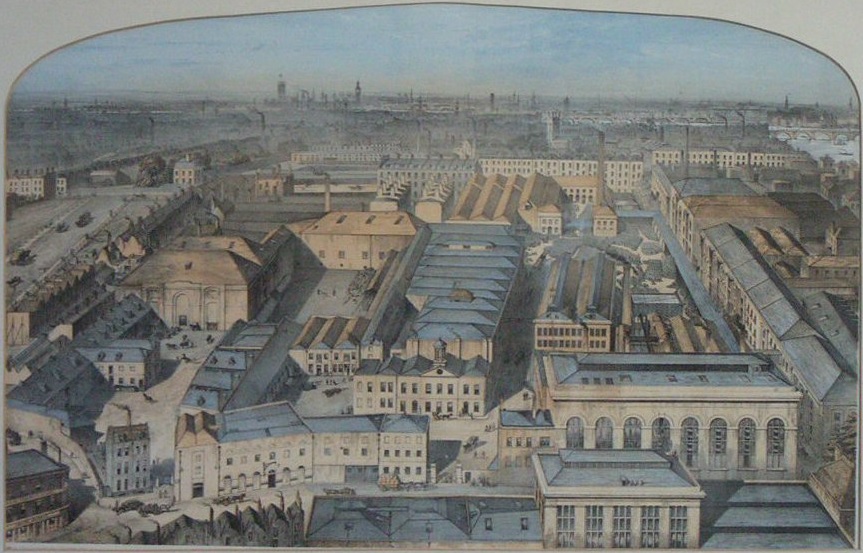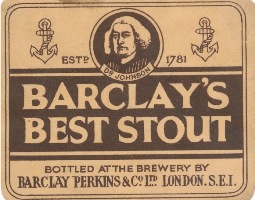Includes information for Barclay Perkins
Courage Brewery
Closed brewery
Anchor Brewhouse, Horseleydown SE1 2LY (Southwark)
First sold beer: 16th century (under an unknown name)
Brewing ceased: 1981
Barclay Perkins & Co
Closed brewery
Anchor Brewery, Park Street SE1 9EQ (Southwark)
First sold beer: 1616 (as Monger’s Brewery)
Brewing ceased: by 1963
The Anchor Brewhouse stood on the south bank of the Thames at Horseleydown, immediately to the east of the present Tower Bridge, at least from the 16th century. It was one of many small brewhouses that once flourished beside or close to the Pool of London, the stretch of river that formed London’s original port. In 1571 it appears to have been owned by a Flemish expatriate, Wessell Webling. This was a time when most beer drunk in England was still unhopped ‘ale’, and hopped ‘beer’ was a continental novelty introduced by immigrants from the Low Countries.
In 1787, then-owners the Ellis Family sold the brewery to a consortium led by John Courage (1761-97), an ambitious shipping agent born in Aberdeen of French Huguenot descent. By now, adding hops had become the norm in English brewing, and the term ‘ale’ had changed its meaning, among other uses applied to modestly hopped ‘running’ or ‘mild’ ales intended to be drunk fresh, as opposed to long-matured beers like the porter for which London was now famous. Courage bucked the porter trend by focusing on ale brewing.
From 1797 the firm was known as Courage & Donaldson but by the time it was registered in 1888 it was simply Courage. The site had by then expanded significantly and was rebuilt in 1894-95.

Courage continued to expand in the 20th century, taking over other brewers in London and elsewhere and eventually becoming one of Britain’s ‘big seven’ brewing groups, starting with the Alton Brewery in Hampshire in 1903. In 1955 it merged with nearby Barclay Perkins (see below) to become Courage & Barclay, and five years later merged again with Simonds of Reading to create Courage, Barclay & Simonds. In 1961, it acquired the Bristol Brewery (George’s) along with its near-1,500 pubs. Another big takeover was John Smith’s in Tadcaster, North Yorkshire, in 1970, a substantial regional with around 1,800 pubs.
Among its other London acquisitions were the Camden Brewery (opened 1859, bought 1923, closed 1925), Hodgson’s in Kingston upon Thames (opened c1610, bought 1943, brewing ceased 1949), Reffell’s in Bexley (opened 1874, bought and closed 1956), Harman’s Uxbridge Brewery (opened c1730, bought by Mann’s 1925, sold to Courage 1962, closed 1964) and Charles Beasley in Plumstead (opened 1845, bought 1963, closed 1965).
By the 1970s, Courage was particularly noted for three beers: cask Best Bitter (~4%), which was likely made to a slightly different recipe at the various breweries to suit local tastes; cask Directors Bitter (~4.8%), which originated at the Alton Brewery in the late 19th century as a brew reserved for the directors and their guests but was subsequently commercialised; and Imperial Russian Stout (~10.5%), a bottle-conditioned beer inherited from Barclay Perkins (see below). All of these were produced in London, though not necessarily exclusively.
According to the 1977 Good Beer Guide, Horseleydown also brewed a cask dark mild (~3.2%). Among the other Courage brands were Tavern keg bitter (~3.9%) and various bright bottled beers like Light Ale (~3.4%, brewed in Plumstead between 1963-65), Brown Ale, Velvet Stout, John Courage strong pale ale (by now likely no stronger than 5%) and Barley Wine, though some of these may well have been produced at other sites.
Where are they now?
In 1972, the group, now known simply as Courage, was itself taken over by the Imperial Tobacco Group. Like many other large London-based brewing groups, the company began reconsidering its future in the capital, and finally closed its historic Horseleydown site in 1981, transferring production to other sites like Bristol (closed 1999 and since redeveloped) and a new brewery at Worton Grange in Reading which had replaced Simond’s in 1980 (itself closed in 2010).
By then, many of the once-busy surrounding wharves and warehouses, like the rest of London’s historic docks and port areas, had fallen into disuse and dereliction, incapable of accommodating ever-larger container vessels. Following the creation of the London Docklands Development Corporation (LDDC) in 1981, Horseleydown became one of the earliest former port areas to be regenerated. The Courage site was redeveloped between 1985-89, converted to upmarket flats, offices and shops.
When Imperial changed hands in 1986, the new owners sold Courage to Australian national brewer Elders IXL, later renamed Fosters Group after its best-known brand. Following the 1990 Beer Orders, a set of government regulations aimed at restricting the tied house system which had far-reaching consequences for the structure of the brewing industry, Fosters’ Courage subsidiary took over the brewing side of Grand Metropolitan (Watney) in 1991 while both breweries’ pubs were spun off into an arm’s-length, jointly-owned company, Inntrepreneur. This pub estate has long since passed into other hands, primarily Stonegate.
Another former Big Seven brewing group, Scottish & Newcastle, bought Courage from Fosters in 1995 to create Scottish Courage, which also had extensive brewing interests outside the UK. This in turn fell to a hostile joint takeover bid by two multinationals, Carlsberg of København and Heineken of Amsterdam, in 2008, with Heineken taking control of the UK brewing side.
The Courage beer brands were sold to Wells & Young’s of Bedford (see Young’s) in 2007, passing to Charles Wells in 2011 when Young’s withdrew from the consortium; to Marston’s when it bought the Wells Eagle Brewery in 2017; and to Carlsberg when it acquired majority control of Marston’s brewing interests in 2020. Following the sale of the Eagle to Damm of Barcelona in 2022, Courage beers are now brewed at Marston’s in Burton upon Trent. The only beers still in regular production are cask Bitter (4%) and Directors (now subtitled ‘Superior Ale’, 4.8%) and bottled Light Ale (3.3%), though Imperial Russian Stout (10%), which was last brewed in London in 1981 and last brewed by Courage at Tadcaster in 1993, was sporadically revived at Wells in the early 2010s.
Things to see
The 1895 brewhouse, boiler house and malt mill with its distinctive cupola and chimney, still stands immediately downstream of Tower Bridge. There’s a good overview from the east side of the bridge, and the landward side, still with its Courage nameplate and various plaques, can be admired from Shad Thames (44 Shad Thames SE1 2LY). An alleyway on the left side of the building leads to Horseley Down Old Stairs dating from at least the early 18th century, giving access at low tide to the foreshore where you can enjoy a closeup view of the brewhouse, including mooring rings for boats making deliveries and collections.
The Anchor Tap, 20A Horseleydown Lane SE1 2LN, was built as the brewery tap likely in the first half of the 19th century. It’s now Grade II-listed and operated by Samuel Smith. It has a one-star heritage interior in recognition of its original bar counter, panelling and fireplaces. Another historic brewery building adjoins it to the southwest, and the brewery site extended into what’s now Brewery Square behind.
The Jacob the Dray Horse statue is a short walk away at the Circle, Queen Elizabeth Street, SE1 2JE. This powerful sculpture by Shirley Pace, installed in 1987 as the centrepiece of a luxury housing development, marks the former site of the brewery stables.
Barclay Perkins

Just upriver on Park Street, Bankside, was another celebrated London brewery, confusingly known as the Anchor Brewery rather than Brewhouse. It was built by former clothworker James Monger (d 1657) in 1616 adjacent to the site of William Shakespeare’s original Globe theatre, which had burned down three years previously (the current Globe, overlooking the river 230 m to the north, is a 1997 replica). It later passed through the hands of the Child and Halsey families and was likely already a relatively important brewery by 1693, when one of the partners, James Child, was appointed Master of the Brewers’ Company.
Ralph Thrale (1698-1758), nephew of another partner, Edmund Halsey, bought the brewery in 1731 and he and his son Henry (1724?-81) developed it into a substantial porter brewery, the seventh-largest in London by 1760 when it was producing over 50,000 hl a year. It was particulary technologically advanced for its day: it was likely the first brewery to adopt regular use of the saccharometer for precisely monitoring the progress of fermentation in 1770, and one of the first to commission a steam engine from James Watt in 1789.
Henry Thrale was born in a pub on nearby Harrow Corner, now the stretch of Park Street that bends towards Stoney Street and Borough Market, so possibly on the site of what’s now the Market Porter (see Old London Bridge Brewery). In 1763, he married Hester Salusbury (1741?-1821), a diarist, writer, arts patron and proto-feminist. Profits from the brewery were substantial enough for the couple to enjoy something of a bohemian lifestyle at Streatham Park, a country mansion originally built for Ralph in Tooting, where their circle of ‘Streatham Worthies’ included writers Edmund Burke and Oliver Goldsmith, actor David Garrick and painter Joshua Reynolds. They became particularly close friends with writer, lexicographer and coiner of bons mots Samuel Johnson (1709-84), who occupied apartments at Streatham Park and sometimes stayed at the brewery. Indeed it seems Hester and Samuel’s relationship went beyond ordinary friendship.
Henry, who lacked technical expertise in brewing, largely left management in the hands of chief clerk John Perkins. Hester, meanwhile, took an active interest in the business but wasn’t particularly fond of Perkins. When Henry died in 1781, she decided to sell, and enlisted Johnson, one of the executors to assist her. They entered successful negotiations with Robert Barclay and his nephew David Barclay, of the well-known Quaker banking family. When the bankers questioned the brewery’s value on the day of the sale, Johnson riposted: ‘We are not here to sell a parcel of boilers and vats, but the potentiality of growing rich beyond the dreams of avarice”, which gives some indication of the wealth London breweries were generating at the time. Perkins was cut into the deal as a partner and the brewery renamed Barclay Perkins & Co.
The brewery prospered under new management, becoming what’s widely thought to be the biggest in the world by 1815, when it was producing just under 500,000 hl a year. It expanded further following a fire in 1832, and with its impressive halls of tall porter tuns and cutting edge technology it became a VIP attraction. Among its visitors were German statesman Otto von Bismarck, French politician Louis-Napoléon Bonaparte (later Napoléon III), Egyptian general Ibrahim Pasha and Italian revolutionary Giuseppe Garibaldi. An 1850 visit by Austrian general Julius Jacob von Haynau, notorious for his bloody and ruthless suppression of the revolutions in Austria-Hungary in 1848, resulted in an international incident when he was attacked and badly beaten by draymen and other brewery workers chanting ‘Down with the Austrian butcher!’
Like other porter breweries, Barclay Perkins brewed porter at several different strengths and by the end of the 18th century, the strongest porters (likely 10%+) were particularly known for their popularity in the Baltic trade, with a claim in 1796 that Barclay’s version was ‘specially brewed for the Empress of Russia’, Catherine II (‘the Great’, Екатери́на Вели́кая, reigned 1762-96). Though this trade had dwindled by the end of the 19th century thanks to various political and taxation barriers, the brewery continued to market strong bottled porter domestically, branding it Barclay’s Imperial Russian Stout.
By this stage, with an annual output now exceeding 800,000 hl, the brewery was no longer exclusively a porter brewery, having added facilities to make fresher, lighter ‘running’ ales in 1885. In 1922, following five years of experiments and the installation of chilled tanks, it widened its repertoire still further by launching a pale London Lager (5.4%), as well as a dark version (5.1%). British-brewed lager was then a rarity, but Barclay’s was so successful that it installed an additional German-style brewhouse in 1930.
By the 1950s the lager was Barclay’s biggest seller, accounting for 20% of sales, which was what attracted the attention of ambitious near neighbour Courage, leading to the merger that created Courage Barclay in 1955. Courage soon wound down brewing activity at Park Street, converting much of the site to a bottling plant in 1958, though lager brewing continued until 1962, by which time a large purpose-built brewery had been commissioned at Courage’s Alton site for Harp lager (closed 2015), produced in partnership with Guinness, Mitchells & Butlers (later Bass Charrington) and Scottish & Newcastle.
The site continued as a bottling plant and depot for a few years, but was disused by the mid-1970s then almost entirely demolished in 1981, replaced by a housing estate and hotel. Had it clung on a few more years, most likely at least some of the historic buildings would have been saved and redeveloped.
Things to see (Barclay Perkins)
The Anchor pub at 34 Park Street SE1 9EF (Bank End) is the former brewery tap. It occupies a Grade II-listed mid-18th century building incorporating some elements from earlier in the century, including a staircase and fireplace, with a later panelled room preserved as the Shakespeare Room on the first floor. It’s now operated by Greene King and a popular tourist spot thanks to its location on the Thames Path.
Various commemorative plaques were installed around the site as part of the 1980s redevelopment. A list of owners can be seen on the western reach of Park Street, behind the hotel (SE1 9EQ). Further along, a depiction of Samuel Johnson is at the corner of Porter Street (SE1 9EA), with the street name also recalling the brewery. Halfway along Park Street towards Maiden Lane (SE1 9EA) is a commemoration of the Haynau incident. Other related street names are Perkins Square and Thrale Street.
At 21-23 Park Street SE1 9EQ is a pair of imposing Grade II-listed yellow brick houses from around 1820, likely built for the Head Brewer and Chief Clerk. The gable end with its 1960s ‘Take Courage’ branding is a familiar landmark to commuters using the railway lines between London Bridge and Charing Cross or Cannon Street.
Up on Southwark Bridge Road along the western perimeter is Anchor Terrace (1-15 Southwark Bridge Road SE1 9HQ), a smart parade of eight houses built for senior brewery employees in 1834 and later used as brewery offices. These were restored in 1958 to match the original design and converted to luxury flats in the 1990s. The northern end of the terrace (closest to the bridge) occupies the site of the original Globe Theatre.
Updated 9 May 2024.
More London breweries
Closed London breweries







Leave a Reply